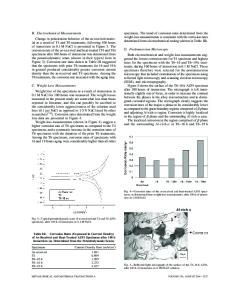Microstructure and Microtexture Formation of AZ91D Magnesium Alloys Solidified in a Static Magnetic Field
- PDF / 1,988,686 Bytes
- 14 Pages / 593.972 x 792 pts Page_size
- 39 Downloads / 351 Views
better performance of an alloy in engineering, it is of great importance to control the microstructure and microtexture that play a vital role in influencing the material properties. Thanks to the rapid development of superconducting magnet technologies, the past two decades have witnessed a significant progress in processing materials in a high magnetic field and various techniques have been developed to produce novel microstructures and microtextures, e.g., the electromagnetic separation of inclusions,[1] ceramics sintering,[2,3] film deposition,[4] and the recrystallization of amorphous alloys.[5] Because of the anisotropy in crystalline lattice, different crystal planes have different magnetic susceptibilities, i.e., different levels of magnetization for crystal planes in response to an applied magnetic field. It is the anisotropy in the magnetic susceptibility that yields the magnetic torque in a static magnetic field and thus drives a crystal to align along its preferential MINGJUN LI and TAKUYA TAMURA, Researchers, and KENJI MIWA, Group Leader, are with the Materials Research Institute for Sustainable Development, National Institute of Advanced Industrial Science and Technology (AIST), Aichi-ken, 463-8560 Japan. Contact e-mail: [email protected] Manuscript submitted July 31, 2008. Article published online April 14, 2009 1422—VOLUME 40A, JUNE 2009
orientation, by which the magnetization energy can be minimized. The earliest experiment using this principle in solidification may be due to Rango et al.,[6] who solidified the YBa2Cu3O7 superconducting oxide in a static magnetic field and found a well-aligned texture. Following this approach, several alloys have been solidified to examine the influence of the static magnetic field on texture formation, e.g., Sm2Co17,[7] Bi-20 at. pct Mn,[8] Al-10 at. pct In,[9] Sn-Pb,[10] and (TbDy)Fe2[11,12] alloys, revealing that the solidified crystals can be well aligned to preferential planes when the magnetic flux density exceeds a critical value. Very recently, Asai[13] reviewed the alignment of crystalline phase in a static magnetic field, including solidification and sintering. When an alloy is remelted and solidified in a crucible, the microstructure of the ingot can be categorized into three zones.[14] The aforementioned studies mainly focused on the influence of a static magnetic field on the inner equiaxed zone. A comprehensive examination of the influence of a static magnetic field on the microstructure and microtexture formation in three zones is still absent. Moreover, increasing applications of the AZ91D (with a nominal composition of Mg-9 wt pct Al-1 wt pct Zn for diecasting) alloy have been found in industry in recent years. However, to our knowledge, there have been no reports on the influence of a static magnetic field on microstructure and microtexture formation for the AZ91D alloy during solidification. METALLURGICAL AND MATERIALS TRANSACTIONS A
Because the alloy is magnesium based with a hcp structure that may generate magnetic anisotropic susceptibilities between the c axis and
Data Loading...











